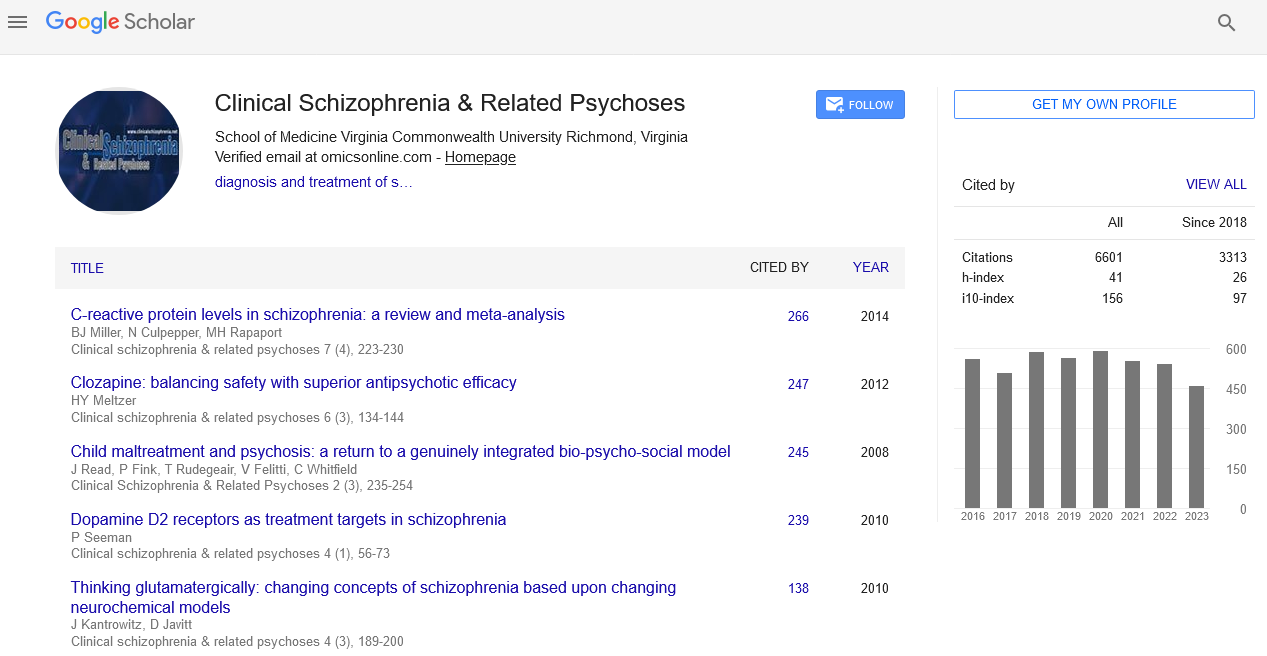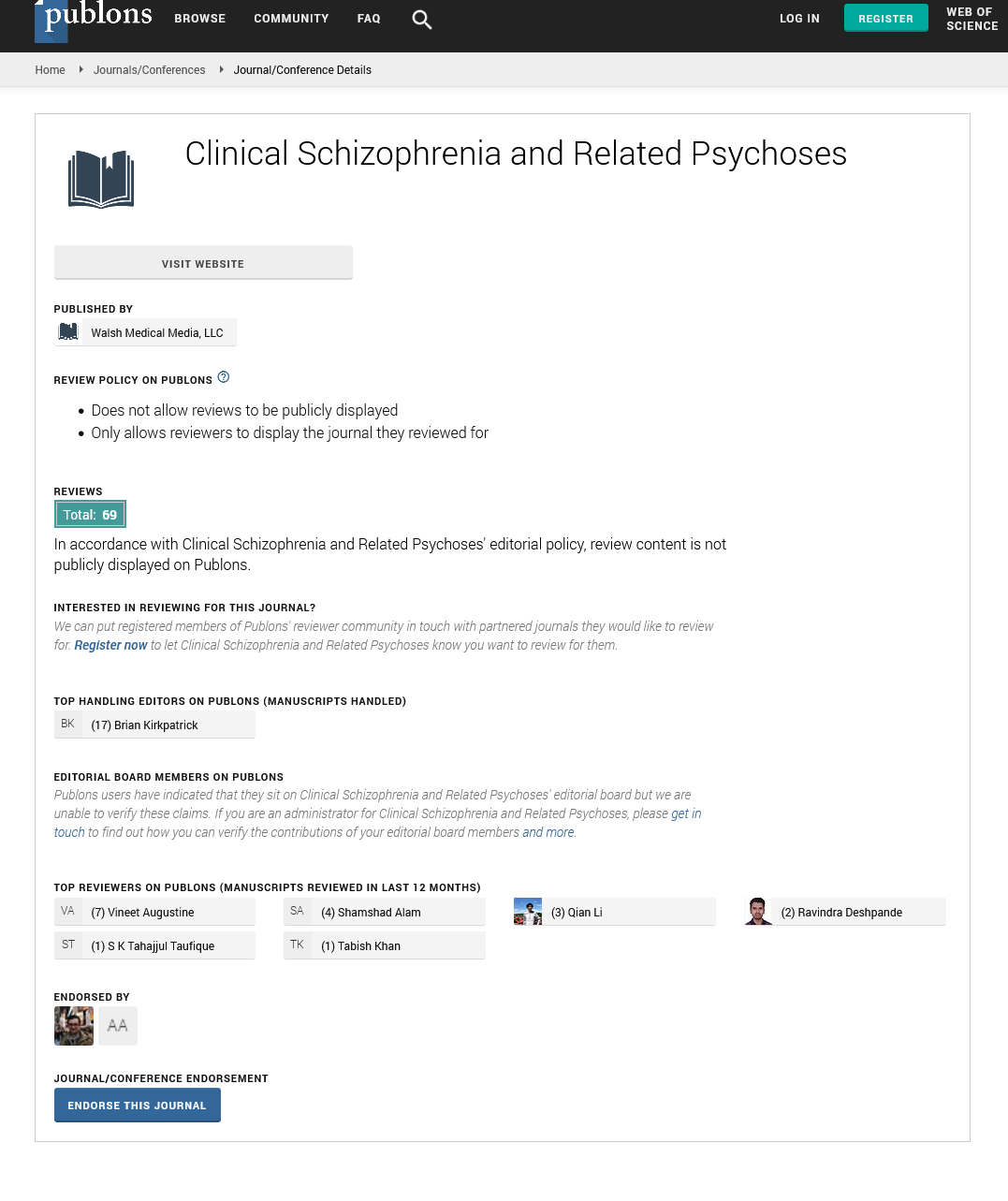Case Report - Clinical Schizophrenia & Related Psychoses ( 2022) Volume 0, Issue 0
Aggressive Behavior in Children with Attention Deficit Hyperactivity Disorder
Mohammad Nayef Ayasrah1* and Mohamad Ahmad Saleem Khasawneh22Assistant Professor, Special Education Department, King Khalid University, Saudi Arabia
Mohammad Nayef Ayasrah, Associate Professor of Special Education, Al Balqa Applied University/ Faculty of Educational Scienc, Jordan, Email: mohammadmtlaq@bau.edu.jo
Received: 07-Dec-2022, Manuscript No. CSRP-22-82598; Accepted Date: Dec 23, 2022 ; Editor assigned: 09-Dec-2022, Pre QC No. CSRP- 22-82598 (PQ); Reviewed: 19-Dec-2022, QC No. CSRP-22-82598 (Q); Revised: 22-Dec-2022, Manuscript No. CSRP-22-82598 (R); Published: 25-Dec-2022, DOI: 10.3371/CSRP.MMWY.100133
Abstract
The purpose of this study is to examine how often and how intensely children with Attention Deficit Hyperactivity Disorder (ADHD) display aggressive behavior. Qualitative descriptive research from a phenomenological perspective is conducted via in-depth interviews and observation in this study. To rule out the possibility of data manipulation, we did a cross-verification of the collected data. The informant's significant other's interview data and the outcomes of the observations were compared to the interview data to get this conclusion. Descriptive statistics were employed to examine the data. Children with Attention Deficit Hyperactivity Disorder were shown to be more prone to engage in violent conduct when their needs were not met, when they were in a foul mood, when they were angered by their parents or classmates, and when they were exposed to negative environmental circumstances. Aggressive actions, such as striking, kicking, pinching, and throwing, are more common in children with ADHD. Negative outcomes of violent conduct in the classroom include social isolation, a deterioration in academic performance, and the development of learning difficulties.
Keywords
Attention Disorder • Aggressive Behaviour • Relationship
Introduction
The label Attention Deficit Hyperactivity Disorder (ADHD) refers to a brain disorder that has been validated as a medical condition all over the globe and covers cognitive processes [1]. People who are affected by this condition struggle to control their emotions, behave in a restrained manner, and pay attention to a single task for an extended period of time. ADHD is a disorder that has been shown to impact a sizeable percentage of children who are of school-going age [2]. It is possible to identify the signs and symptoms of Attention Deficit Hyperactivity Disorder (ADHD) in a child prior to the age of seven. These manifestations often take place in the child's surroundings and in a variety of contexts, including the child's home, school, play area, and other areas of the child's life.
The inability to concentrate, a lack of self-control, and hyperactivity are the basic signs of attention deficit hyperactivity disorder (ADHD). One of the symptoms of inattention is that the child will often give the idea that they are unable to concentrate, which is one of the warning indicators [3]. Their capacity for concentration is noticeably altered when there is simultaneous stimulation of all of their senses in the environment. The inability to focus for extended periods of time is one of the symptoms of attention deficit hyperactivity disorder (ADHD), which makes it challenging for affected children to take in information from their environments (environment) [4].
One of the indicators of impulsivity is children who have issues with their attitudes or experience disharmony between their thoughts and actions. This may occur in children who have attention deficit hyperactivity disorder (ADHD) (disorder among think and do) [5]. They respond very quickly due to the fact that the feature of feeling or sensation is so predominated in their perception. This disease causes disturbances not only to the children's personalities but also to the places in which they live. When children are active, they also have difficulties in establishing priority scales; this condition results in issues for adults who work with children.
Children who show indications of hyperactivity engage in activity in the form of excessive motor movements that are at a greater level than the average level of motor activity of children their age who are regarded as having normal levels of motor activity. They never come to a complete stop moving, and even when they have clear goals in mind, it may be extremely challenging to convince them to calm down. Children who display both hyperactivity and impulsivity, particularly if they do so on a constant basis, may have significant issues in their academic performance [6]. This is especially true if the children show both of these behaviours consistently. Numerous potential contributors might be to blame for these challenges.
In addition, aggressive behaviour and disruptive behaviour are both included under the umbrella term of disruptive conduct. The act of behaving in a manner that requires constant monitoring is known as disruptive behaviour. Some examples of disruptive conduct include not wanting to listen, demanding attention, disturbing classmates, hitting, and other similar activities. Disruptive behaviour may also take the form of other comparable behaviours [7]. According to the psychoanalytic point of view, the subconscious of human beings has the ability to participate in thanatos, which may be translated as self-destruction [8]. The following explanations are provided for the correlation between authoritarian parenting and violent behaviour: Aggressive conduct is activity that has the goal of hurting either physically or verbally and contains features of physical aggressiveness, rage, and hostility. Aggressive behavior may be defined as behaviour that has the objective of harming both physically and verbally. Parenting styles based on authority have a tendency to foster violent conduct [9].
reasons, including biological, psychological, and environmental influences. When aggressive behaviour happens in the human brain, specific regions, such as the limbic system, which is driven by electric currents, produce waves [10]. In addition to this, what impacts aggressive behaviour is the hormone testosterone, which may also be a cause of aggressive conduct. Emotional disturbances are the driving force behind violent conduct, which has a psychological component. Someone's hostile conduct may be caused by emotional blindness on their part. When a person is confronted with upsetting experiences, the lack of emotional awareness that person has will cause them to react in a way that is instinctive and out of their control.
When children with special needs display aggressive conduct, this is seen as a sign of a disrupted behaviour pattern in these children. Aggressors are a term used to describe children who exhibit aggressive conduct [11]. There are some who behave aggressively in a proactive manner and others who act aggressively in a reactive manner. The proactive aggressor is a youngster that has a high level of aggression with the intention of using violent conduct as a means to find solutions to societal issues or realize personal objectives. The second type of aggression is called reactive aggression, and it occurs when a child displays a high level of hostility, feels provoked because he already feels hostility toward other people, and is unable to control the anger that is experienced in order to find solutions that do not involve aggressive behaviour. The traits of children who have exceptional needs who exhibit violent conduct.
Parents of children with special needs, particularly those diagnosed with ADHD, need to have a better understanding of how to avoid aggressive behaviour in their children and should be encouraged to take preventative measures. It is essential for children with ADHD to be able to make successful social adjustments so that they may be accepted by society on an equal footing with children in general and do not contribute to the perpetuation of existing issues.
Methods
This kind of study is known as qualitative research, and its primary emphasis is on describing people's experiences. It is known as a case study, and it is a type of study that involves the collection of data through field observations to learn about aggressive behaviour in children who have ADHD as well as interviews with both parents and teachers to learn more about the aggressive behaviour of children who have ADHD. The purpose of this research is to gain a better understanding of the aggressive behaviour of children who have ADHD. Throughout the whole of the period devoted to the collecting of data for this investigation, the methods of observation, interviewing, and documentation were applied. In this specific piece of study, the process of data analysis is broken down into three separate processes that are carried out in sequential order. Reducing the amount of data, presenting the facts, and making conclusions are the three processes in this process.
Results and Discussion
Factors of aggressive behavior in children with attention deficit disorder
igin of violent behaviour could lie either inside the individual or within an environment that is unable to recognize what it is that the subject desires. It's conceivable that the subject had problems getting their words out, which is why the background is so distracting. It's possible that the fact that he hates the class and spends most of the time feeling bored contributes to the fact that he behaves in an angry manner toward the problem at hand. Because the person in question frequently travels outside of the city and hangs out with adults, there is a greater chance that they will listen to and internalize language that is inappropriate for their age and that they will subsequently use when they are angry. This is because the individual in question is frequently angry. Even when other environmental factors, such as the presence of friends, are accounted for, the fact that the subject is hungry is a substantial contribution to his aggressive behaviour [12]. This is true even when the subject's behaviour is observed in isolation. Because they are unable to communicate effectively, youngsters might be hostile, which is one of the factors that contributes to the issue. This is also one of the factors that contributes to the problem.
The kind of aggressive behaviour that is directed at the target is included in the category of physical aggression. This type of aggression causes injury to both the victim and the aggressor by hitting or hurling objects at them [13]. The aggressive behaviour that is seen in the classroom is, for the most part, identical to what is seen outside. This includes choking and kicking, two forms of physical aggression that are included in this category. During some of the other sessions, the classroom was also the setting for various types of aggressive behaviour. These actions included stealing a game from a buddy, refusing to take turns, and striking another student until they got into a fight with each other. This pattern of violent behaviour includes components of both physical and verbal violence, as well as hostility, and it has been going on for quite some time.
They are older than 5 years old at this point in their lives; nonetheless, they are unable to communicate effectively due to the fact that the language that they use is restricted and cannot be understood by others. When they want something, they either make a gesture with their hands or make a "eh-eh" sound to indicate their want. Even though one of the symptoms of ADHD in children is excessive talking and a tendency to interrupt others while they are talking, research has shown that children who have ADHD frequently have delayed speech development. This is the case despite the fact that one of the symptoms of ADHD in children is the tendency to talk excessively. Children who suffer from Attention Deficit Hyperactivity Disorder (ADHD) have been proven in several studies to have problems communicating verbally. Children who have ADHD have trouble formulating whole sentences, remembering words over a short period of time, and linking word assignments [14]. This is a hypothetical situation. Memory is affected in children who have attention deficit hyperactivity disorder (ADHD), both in terms of their capacity to remember knowledge and their ability to retain it.
Children who have ADHD often experience speech difficulties, which may result in a breakdown in communication between the child and the person to whom they are speaking. This, in turn, can cause anger on both the part of the child and the person to whom they are speaking. According to the idea that defines the causes of anger that are frequent in children, common reasons for anger in children include fights over games, not achieving desires, and attacks from other children. Children will express their rage by crying, shouting, starting fights with other children, kicking, jumping, or hitting other children. Children will even pick fights with adults. Concerning this matter, some actions, such as fighting while playing, weeping at the same time, and shouting at the same time, come up at the same time as the concept that Hurlock had. In addition, the inclination for children to engage in aggressive behavior often reaches its highest point between the ages of two and four years old. In the past, physical attacks were often followed by verbal assaults, such as cursing or placing blame on other parties. Today, however, physical assaults seldom occur without verbal assaults.
According to the findings of this study, the emotion that predominated in the violent behaviour that was displayed by the four young people was rage. This conclusion was reached based on the findings of the research. Anger directed toward children often has its origins in unfulfilled desires, resentment against other people or friends, negative emotions, unfavourable environmental conditions, and behavioural issues [15]. This environmental aspect is what differentiates the reasons for the behaviour of children who have ADHD from the causes of the behaviour that occurs in children in general, such that children who have ADHD acquire negative consequences from their surroundings.
The relation of attention deficit disorder with aggressive behaviour
A person is considered to be participating in aggressive behaviour when they make it their purpose to hurt or offend other people, either physically or verbally, or when they make it their goal to do physical damage to goods that have the potential to cause harm to themselves or others. On the other hand, one cannot consider a behaviour to be aggressive if it is carried out without the intention to cause harm. For instance, the medical treatments carried out by physicians while they are treating patients do not fall into this category because they are not done with the intention to cause harm. Although there is a purpose behind it, we cannot consider the suffering that follows to be the outcome of an act of violence. The chain of causation, however, activity that is meant to cause damage to another person is still seen as hostile behaviour, even in the event that the harm does not materialize in the way that was intended.
The results of this research indicate that children who have Attention Deficit Hyperactivity Disorder, or ADHD for short, are more prone to engage in aggressive behaviour than children who do not have the disorder. Children who suffer from Attention Deficit Hyperactivity Disorder (ADHD) struggle to focus their attention, are unable to sit still for long periods of time, and move about quite a bit. This attention deficit hyperactivity disorder, often known as ADHD, is characterized by a feeling of restlessness, an inability to stay still, repeated efforts to get up, intense emotional outbursts, excessive activity, and the creation of excessive noise. Due to the fact that these children have these aspects of personality, it is quite unusual for children who have ADHD to engage in violent behaviour.
The findings of this study indicate that the people in question have all of the basic signs of ADHD, which include hyperactivity, inattention, and impulsivity. Both hyperactivity and a general inability to concentrate are among the most common manifestations. The four people who are taking the exam struggle to maintain their concentrate on a single activity, and it is easy for them to shift their attention away from what they are now doing. This conclusion is consistent with the theory that claims that children who suffer from ADHD often demonstrate an uneven mix of activity and hyperactivity. Activity and hyperactivity are both behaviours that may hinder children's capacity to learn and their academic success. The theory that was stated previously, the individual could exhibit signs of inattentiveness and hyperactivity. For example, they might be unable to focus on a single task and behave in an excessively active way [16]. In addition, the results of the interviews indicated that inattention and hyperactivity were the most evident symptoms of ADHD in all four of the persons who participated in the research. These findings were reported by the participants in the study who were interviewed.
This research, in contrast to those that came before it, intends to explore the prevalence of violent behaviour among children who have ADHD. The studies that came before this one focused on children between the ages of 4 and 6 years’ old who did not have to meet any special standards. The results of this study do disclose how children aged 4-6 years old experience aggressive conduct; however, the findings do not reveal how children who have attention deficit hyperactivity disorder (ADHD) experience aggressive behaviour.
The components, forms, and effects are all made abundantly evident when seen through the lens of the characteristics that are shared by children with ADHD. This is one of the primary advantages that comes from doing this study [17]. There is no research that truly proves the prevalence of aggressive behaviour among children who have special needs, particularly those who have Attention Deficit Hyperactivity Disorder (ADHD). In addition, researchers show up to the school well before the start of classes and don't depart until after all of the test participants have gone home. This is done on purpose so that the researchers are able to make accurate observations. In addition to taking precautions to avoid asking questions that may be seen as offensive, the researcher uses language that is plain and easy for members of the general public to understand.
This research has a few shortcomings, the most significant of which are the restricted number of informants that were employed and the lack of precise information on the questions that were posed by the researchers. In addition to that, the responder was given a time restriction in order to answer given the restricted amount of time that was available. The interview was conducted in a single sitting since both the limited amount of time that the informant could provide while at school and the fact that the research could only be carried out at school necessitated that this be the case. The amount of information that has been gathered by researchers as a result of this is diminished dramatically.
Conclusion
According to the evidence that was discussed in the preceding exchange, there are still some parents who do not recognize that there is an issue with their child until it is much too late to do something about it. Following that, the therapeutic efforts that were provided were not quite as successful as they may have been, such as discontinuing the treatment that was proposed.
Children who suffer from attention deficit hyperactivity disorder, more commonly referred to as ADHD, are more likely to engage in violent behaviour. This is due to the fact that these children have unmet needs, negative moods, behavioural problems, negative environmental circumstances, and are upset with either their parents or their peers. Children who suffer from ADHD are at an increased risk of engaging in aggressive behaviours such as hitting, kicking, pinching, and throwing, as well as other forms of violent behaviour. The effects of this aggressive behaviour include estrangement from one's environment and social circle, the development of learning difficulties in children when they are enrolled in school, and an increased risk of harm to the kid as well as others who are in close proximity to him. Additionally, children who exhibit this behaviour are more likely to develop learning difficulties when they are enrolled in school.
If parents and instructors do not offer children with ADHD with the required supervision and treatment, then aggressive behaviour in these children could have a negative impact. This might be a result of the ADHD. Children who have ADHD do have the characteristics of always being energetic, of being hyperactive, and of being impulsive. All of these features have the potential to be catalysts for the development of aggressive behaviour in children.
Acknowledgments
The authors extend their appreciation to the Deanship of Scientific Research at King Khalid University for funding this work through Small Research Groups under grant number (RGP.2 /136/43)
References
- Mahone, E. Mark, & B. Denckla, M. "Attention-deficit/hyperactivity disorder: a historical neuropsychological perspective." J Int Neuropsychol Soc. 23.9-10 (2017): 916-929.
- Aishworiya, R., et al. "Screen time exposure and sleep among children with developmental disabilities." J paediatr child health54.8 (2018): 889-894.
- Aguilar-Cárceles, Marta M., & Farrington, David P. "Attention deficit hyperactivity disorder, impulsivity, and low self-control: which is most useful in understanding and preventing offending?." Crime psychol rev. 3.1 (2017): 1-22.
- Von Gontard, A., et al. "Neurodevelopmental disorders and incontinence in children and adolescents: Attentionâ?deficit/hyperactivity disorder, autism spectrum disorder, and intellectual disability—A consensus document of the International Children's Continence Society." Neurourol Urodyn. 41.1 (2022): 102-114.
- Goulet, Jo-Annie S.,& Tardif, M. "Exploring sexuality profiles of adolescents who have engaged in sexual abuse and their link to delinquency and offense characteristics." Child abuse negl. 82 (2018): 112-123.
- Alavi, M., et al. "Attention, impulsiveness, and gender in academic achievement among typically developing children." Percept Mot Ski. 126.1 (2019): 5-24.
- Rios-Gonzalez, O., et al. "Promoting zero violence from early childhood: a case study on the prevention of aggressive behavior in Cappont Nursery." Eur Early Child Educ Res. J. 27.2 (2019): 157-169.
- Petrovsky, V., & Shmelev, I. "Personology of difficult life situations: At the intersection of three cultures." Psychol J High Sch Econ. 16.3 (2019): 408-433.
- Sahithya, B. R., et al. "Parenting styles and its impact on children–a cross cultural review with a focus on India." Ment Health Relig Cult. 22.4 (2019): 357-383.https://doi.org/10.1080/13674676.2019.1594178
- Tible, O.P., et al. "Best practice in the management of behavioural and psychological symptoms of dementia." Ther adv neurol disord. 10.8 (2017): 297-309.
- Girard, L.C., et al. "Development of aggression subtypes from childhood to adolescence: a group-based multi-trajectory modelling perspective." J abnorm child psychol. 47.5 (2019): 825-838.
- Jermacz, Å., et al. "An enemy of your enemy is your friend: Impact of predators on aggregation behavior of gammarids." Ethology 123.9 (2017): 627-639.
- Ybarra, M.L., & Thompson, R.E. "Predicting the emergence of sexual violence in adolescence." Prev. Sci.19.4 (2018): 403-415.
- Hronis, A., et al. "A review of cognitive impairments in children with intellectual disabilities: Implications for cognitive behaviour therapy." Br J Clin Psychol. 56.2 (2017): 189-207.
- Stringaris, A., et al. "Practitioner review: definition, recognition, and treatment challenges of irritability in young people." J Child Psychol Psychiatry 59.7 (2018): 721-739.
- Shaw, P., & Sudre, G. "Adolescent attention-deficit/hyperactivity disorder: understanding teenage symptom trajectories." Biol psychiatry 89.2 (2021): 152-161.
- Schibli, K., et al. "Attending, learning, and socioeconomic disadvantage: Developmental cognitive and social neuroscience of resilience and vulnerability." Ann N Y Acad Sci. 1396.1 (2017): 19-38.
Citation: Ayasrah MN, Saleem Khasawneh MA. "Aggressive Behaviour in Children with Attention Deficit Hyperactivity Disorder". Clin Schizophr Relat Psychoses 16S2 (2022) doi: 10.3371/CSRP.MMWY.100133
Copyright: © 2022 Ayasrah M.N, et al. This is an open-access article distributed under the terms of the creative commons attribution license which permits unrestricted use, distribution and reproduction in any medium, provided the original author and source are credited. This is an open access article distributed under the terms of the Creative Commons Attribution License, which permits unrestricted use, distribution, and reproduction in any medium, provided the original work is properly cited.






